The AMD Trinity Review (A10-4600M): A New Hope
by Jarred Walton on May 15, 2012 12:00 AM ESTAMD Trinity General Performance
Starting as usual with our general performance assessment, we’ve got several Futuremark benchmarks along with Cinebench and x264 HD encoding. The latter two focus specifically on stressing the CPU while PCMarks will cover most areas of system performance (including a large emphasis on storage) and 3DMarks will give us a hint at graphics performance. First up, PCMark 7 and Vantage:
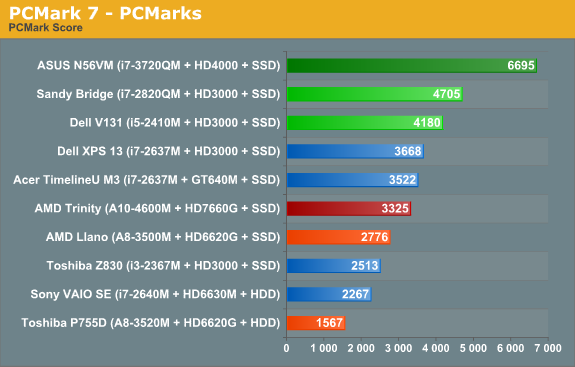
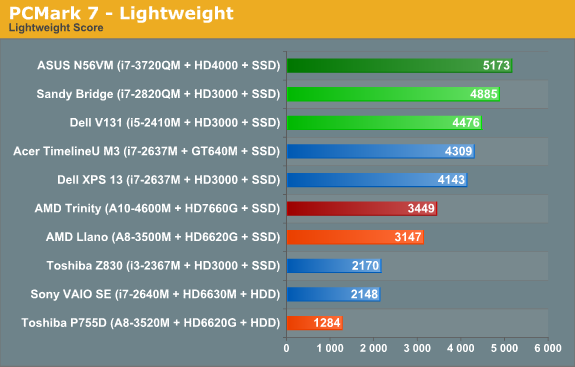
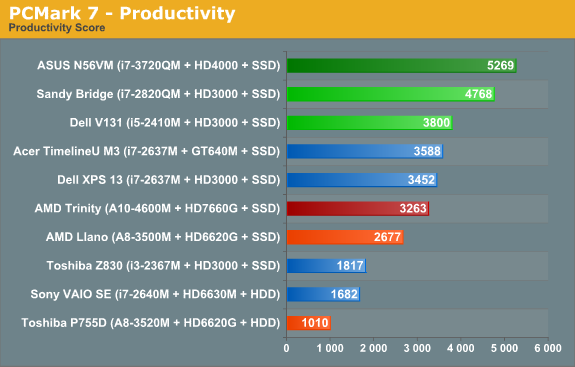

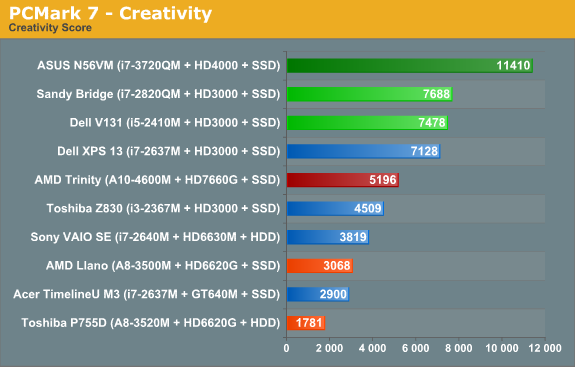
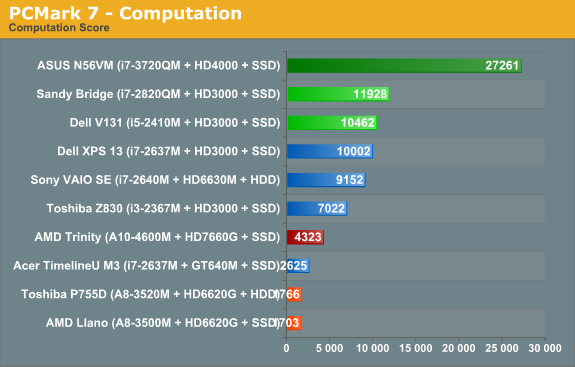
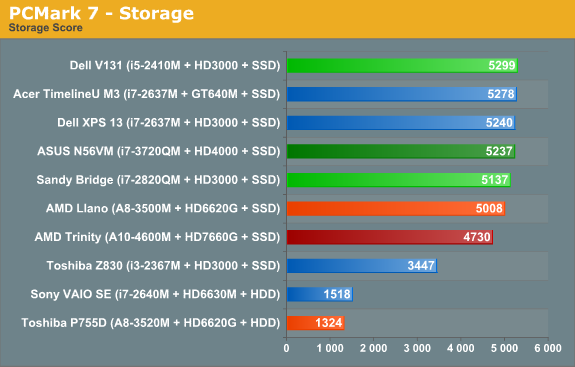
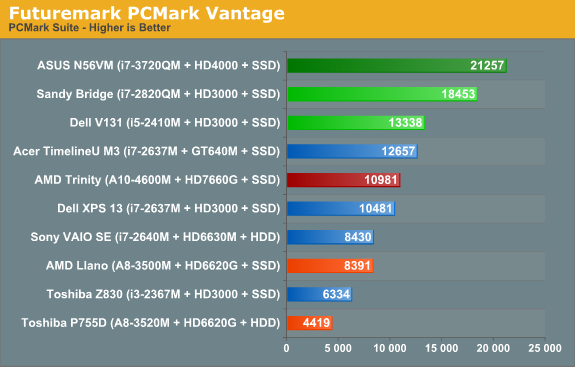
As noted earlier, we ran several other laptops through PCMark 7 and PCMark Vantage testing using the same Intel 520 240GB SSD, plus all the ultrabooks come with SSDs. That removes the SSD as a factor from most of the PCMark comparisons, leaving the rest of the platform to sink or swim on its own. And just how does AMD Trinity do here? Honestly, it’s not too bad, despite positioning within the charts.
Obviously, Intel’s quad-core Ivy Bridge is a beast when it comes to performance, but it’s a 45W beast that costs over $300 just for the CPU. We’ll have to wait for dual-core Ivy Bridge to see exactly how Intel’s latest stacks up against AMD, but if you remember the Llano vs. Sandy Bridge comparisons it looks like we’re in for more of the same. Intel continues to offer superior CPU performance, and even their Sandy Bridge ULV processors can often surpass Llano and Trinity. In the overall PCMark 7 metric, Trinity ends up being 20% faster than a Llano A8-3500M laptop, while Intel’s midrange i5-2410M posts a similar 25% lead on Trinity. Outside of the SSD, we’d expect Trinity and the Vostro V131 to both sell for around $600 as equipped.
A 25% lead for Intel is pretty big, but what you don’t necessarily get from the charts is that for many users, it just doesn’t matter. I know plenty of people using older Core 2 Duo (and even a few Core Duo!) laptops, and for general office tasks and Internet surfing they’re fine. Llano was already faster in general use than Core 2 Duo and Athlon X2 class hardware, and it delivered great battery life. Trinity boosts performance and [spoiler alert!] battery life, so it’s a net win. If you’re looking for a mobile workstation or something to do some hardcore gaming, Trinity won’t cut it—you’d want a quad-core Intel CPU for the former, and something with a discrete GPU for the latter—but for everything else, we’re in the very broad category known as “good enough”.


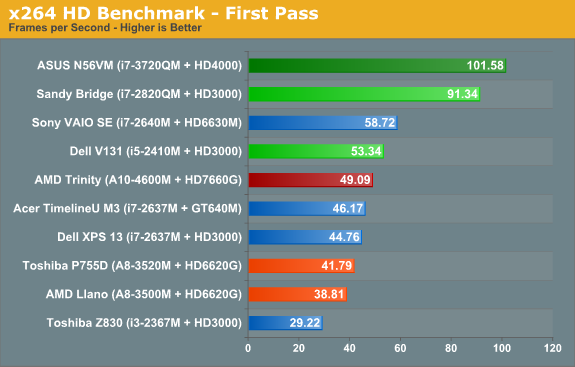
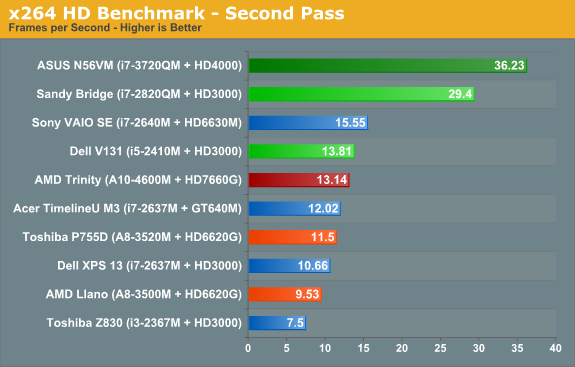
When we start drilling down into other performance metrics, AMD’s CPU performance deficiency becomes pretty obvious. The Cinebench single-threaded score is up 15% from 35W Llano, but in a bit of a surprise the multi-threaded score is basically a wash. Turn to the x264 HD encoding test however and Trinity once again shows a decent 15% improvement over Llano. Against Sandy Bridge and Ivy Bridge, though? AMD’s Trinity doesn’t stand a chance: i5-2410M is 50% faster in single-threaded Cinebench, 27% faster in multi-threaded, and 5-10% faster in x264. It’s a good thing 99.99% of laptop users never actually run applications like Cinebench for “real work”, but if you want to do video encoding a 10% increase can be very noticeable.

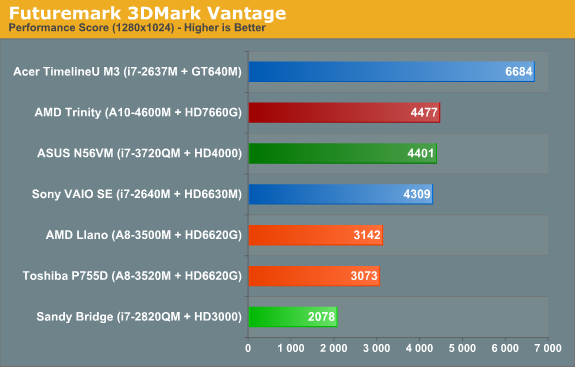
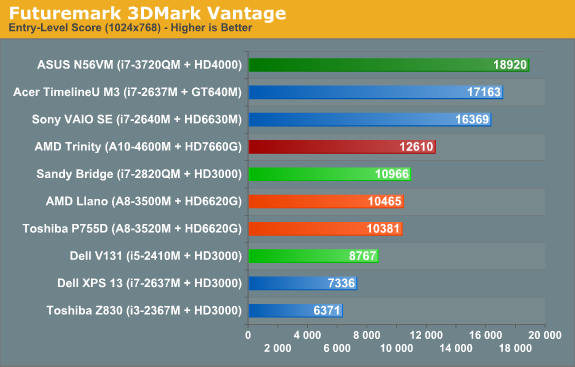
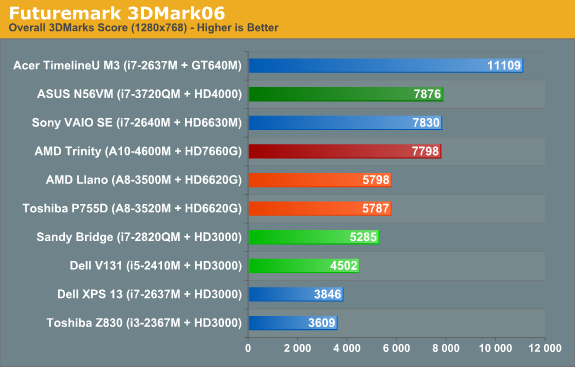
Shift over to graphics oriented benchmarks and the tables turn once again...sort of. Sandy Bridge can’t run 3DMark11, since it only has a DX10 class GPU, but in Vantage Performance and 3DMark06 Trinity is more than twice as fast as HD 3000. Of course, Ivy Bridge’s HD 4000 is the new Intel IGP Sheriff around these parts, and interestingly we see Trinity and i7-3720QM basically tied in these two synthetics. (We’ll just ignore 3DMark Vantage’s Entry benchmark, as it’s so light on graphics quality that we’ve found it doesn’t really stress most GPUs much—even low-end GPUs like HD 3000 score quite well.) We’ll dig into graphics performance more with our gaming benchmarks next.










271 Comments
View All Comments
mdeo - Tuesday, May 15, 2012 - link
" For some of these applications, we don’t have any good way of measuring performance across a wide selection of hardware, and for some of those where benchmarks are possible I’ve run out of time to try to put anything concrete together"Please wait and spend the required time before you post results.
Also, where are the graphs for WinZip, GIMP filters (19 of them ..you deemed 5 that you would use). Graphs make it easy to read that Trinity beats Intel chips in GIMP and equals in WinZip.
This makes me wonder why should I trust Anandtech more then tomshardware reviews ...
JarredWalton - Tuesday, May 15, 2012 - link
You apparently have no idea how much time goes into putting together a review and running all the benchmarks. Let's just say that after running (and rerunning) benchmarks for much of the last month on a variety of laptops, I finished a couple of graphs right at the 12:01 AM NDA time. That was after getting about ten hours of sleep total over the weekend, and never mind the fact that I've had a horrible cold the past week.Every new benchmark needs to be created and evaluated to see if it's useful. GIMP's new "Noise Reduction" and "Blur" functions can use OpenCL, but so can "Checkerboard". Um, really? We need OpenCL to fill an image with a checkerboard?
Here are a few GIMP numbers (from Noise Reduction):
A10 CPU: .396 MP/s
A10 OCL: 4.10 MP/s
IVB CPU: 1.49 MP/s
IVB OCL: 4.04 MP/s
SNB CPU: .689 MP/s
SNB OCL: 3.56 MP/s
DC SNB CPU: .586 MP/s
DC SNB OCL: 2.01 MP/s
Llano CPU: .321 MP/s
Llano OCL: 2.39 MP/s
I had a graph for WinZip, but then we pulled it because apparently WinZip's OpenCL performance is best using the legacy compression. I used their newer Zipx compression, which results in a smaller file but isn't as optimized (yet). So now I need to spend about two hours retesting WinZip and 7-zip. Thanks for understanding.
Beenthere - Tuesday, May 15, 2012 - link
As expected Trinity delivers in all areas and should meet most people's needs quite well. Good job AMD. You get my money!tipoo - Tuesday, May 15, 2012 - link
I wonder what causes these odd results? The 7660 winning by a wide margin in most games, but losing by a small margin in some? Is it whether the games are pixel fill vs pixel shader (hd4000 is good at the former, bad at the latter) bound, or is there a driver issue with the 4000, or what?Wolfpup - Tuesday, May 15, 2012 - link
That has to be the most surprising thing in the review to me. While I know technically today's GPUs are really CPUs geared towards less branchy, more parallel code, it still caught me off guard that someone had thought to run a file compression utility on it!Also surprised Intel has OpenCL drivers at all...not surprised they're bad though. I wonder what they do? Like is their "GPU" portion of Sandy/Ivy bridge actually capable of doing that type of work, or are they mostly just using the CPU?
Still hate "quicksync" and the graphics portion of those CPUs as it's wasting at least enough transistors for a 5th core.
jwcalla - Tuesday, May 15, 2012 - link
File compression can be parallelized, but there are some unfortunate limitations... final compressed size is generally less optimal with parallel compression, and compressing large volumes of data become memory-bound fairly quickly. But for "ordinary" compression tasks it's quite effective.The article didn't indicate if the CPU compression tests were single-threaded or multi-threaded.
Brazos - Tuesday, May 15, 2012 - link
Can I assume the improvements seen here will be implemented in the next version of Bulldozer (Vishera)?mikato - Wednesday, May 16, 2012 - link
Yes, it's supposed to use Piledriver modules, not Bulldozer.silverblue - Thursday, May 17, 2012 - link
Plus even the Piledriver implementation in Trinity should, clock for clock, be faster than Bulldozer even without L3 cache. This isn't a repeat of Llano vs. Phenom II where Husky cores were technically faster than Stars albeit lacked L3 cache which brought the performance back down again.Some information about the caches plus their latency would be really appreciated; if it bodes well here, Vishera might be a very decent chip.
jwcalla - Tuesday, May 15, 2012 - link
Is there really a large market for gaming on a lower-end laptop? I can see us techies being interested in that sort of thing, but what percentage of PC buyers is actually concerned about gaming performance, let alone on a laptop? In real world terms, I'm not seeing AMD's strategy giving it much of an advantage.I'm willing to entertain the reality that Intel has been "overselling performance" to casual users for some time now, and so maybe low-end is more than good enough... but, if true, AMD seems to be focusing on a segment that is going to have an enormous amount of competition in the next 2-3 years.